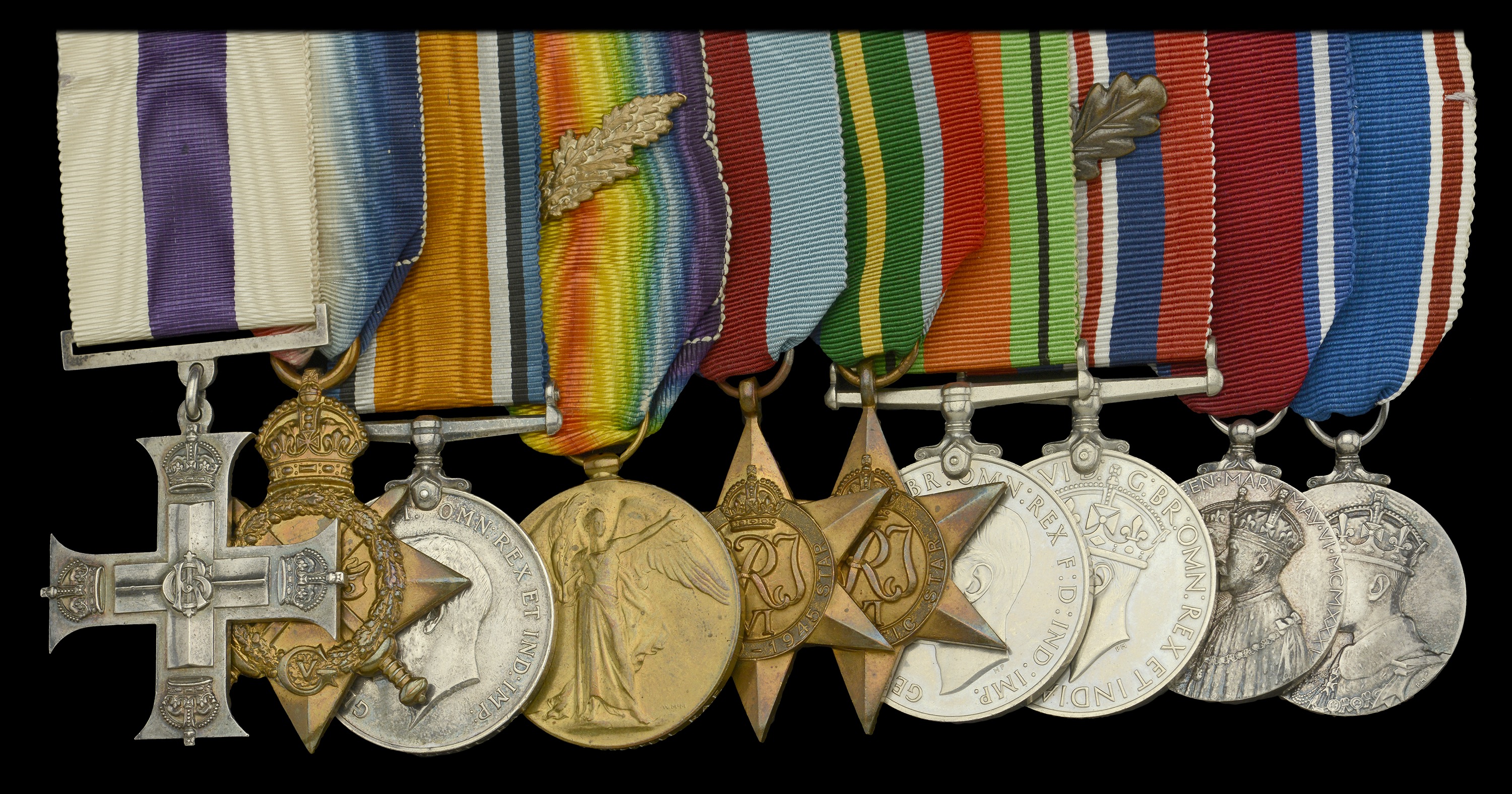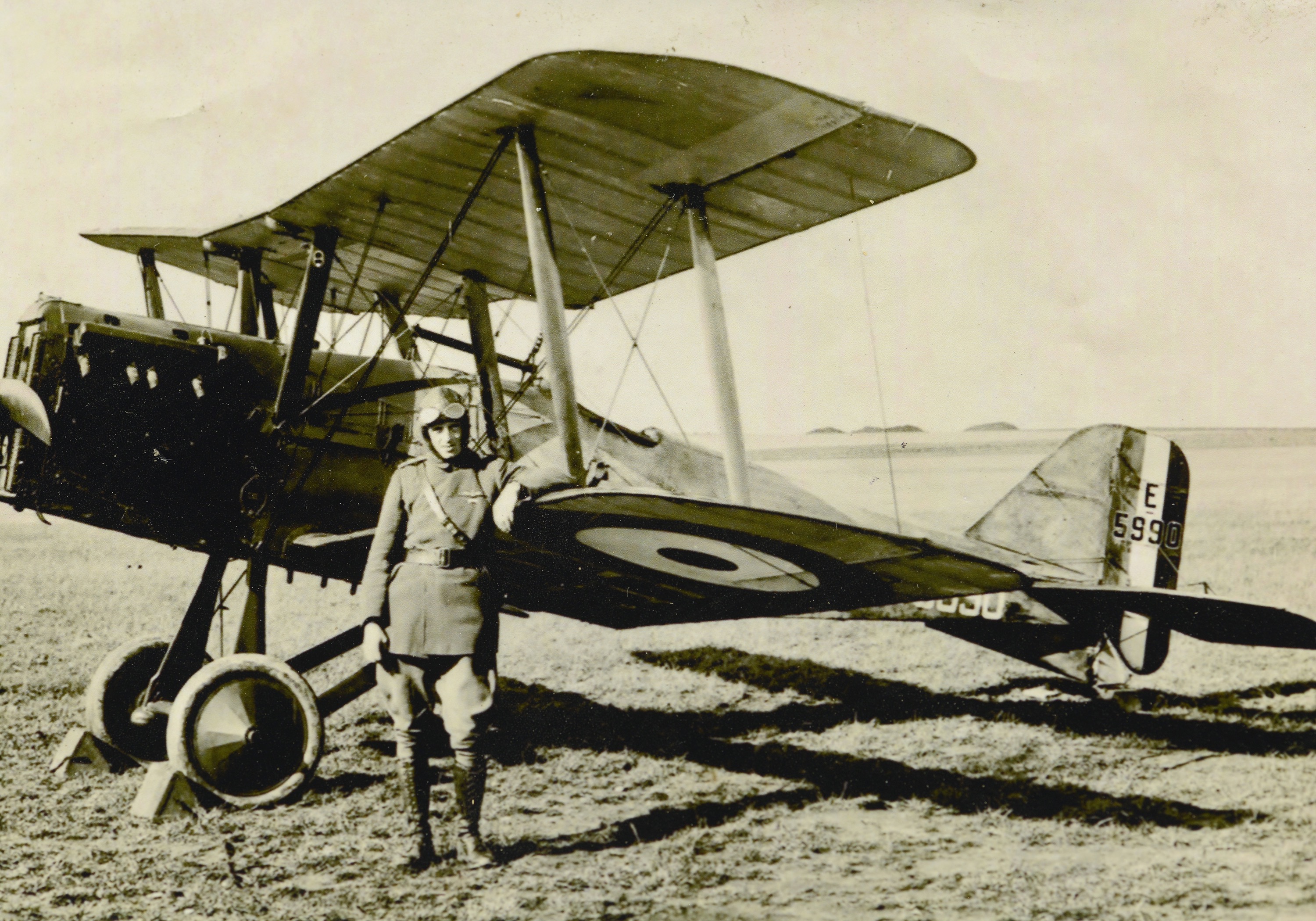76
A good and well-documented Great War 1918 Western Front Fighter Ace's M.C. group of ten...
Bids do not include VAT, buyer’s premium or delivery.
By confirming your bid, you agree that you have read and accepted the-saleroom.com and the auctioneer's terms and conditions. Confirming your bid is a legally binding obligation to purchase and pay for the lot should your bid be successful.
Choose one of the quick bid options below:
Bids do not include VAT, buyer’s premium or delivery.
By confirming your bid, you agree that you have read and accepted the-saleroom.com and the auctioneer's terms and conditions. Confirming your bid is a legally binding obligation to purchase and pay for the lot should your bid be successful.
A talented linguist, Chappell was stationed at the British Embassy in Tokyo between the wars. From here he naturally segued into R.A.F. Intelligence, and was seconded for duty as an instructor with the Imperial Japanese Navy in September 1930. His pupils, amongst others, included a Commander Minoru Genda - who later planned and led the infamous attack on Pearl Harbour in Second World War. With the outbreak of the Second World War Chappell was appointed Deputy Director of Intelligence, Air Ministry, Far East Section. As Japan invaded Malaya and Singapore in 1942, Chappell left for Java, flying to Britain via Calcutta, Cairo and Equatorial Africa
Military Cross, G.V.R., reverse engraved ‘Capt. R. W. Chappell, R.F.C. March 1917 France.’; 1914-15 Star (Pte. R. W. Hartigans Hse.); British War and Victory Medals, with M.I.D. oak leaves (Capt, R. W. Chappell. R.A.F.); 1939-45 Star; Burma Star; Defence and War Medals 1939-45, with M.I.D. oak leaf; Jubilee 1935; Coronation 1937, mounted for wear, generally very fine or better (lot) £4,000-£5,000
---
M.C. London Gazette 22 June 1918:
‘For conspicuous gallantry and devotion to duty. He showed the greatest skill and courage in leading patrols, with the result that during four days' operations the formations which he led destroyed 19 enemy aeroplanes and drove down several others, the fate of which was not observed, owing to the intensity of the fighting. He has destroyed altogether five enemy machines, and has driven down seven others out of control.’
The original recommendation, from which the above was taken, varies a little and notes 12 enemy aircraft accounted for by 6th April 1918 (the date of the recommendation). It its also more specific a time period, which was for the German ‘March Offensive’, an incredibly confused and chaotic period on both land an air:
‘‘For continued Gallantry and good service in the field, especially during the recent operations. From March 21st to March 25th 1918, whilst on offensive patrols, this Officer has led his formations with the greatest skill and Gallantry. As a result of these patrols Capt. Chappell’s formations destroyed 18 EA, whilst he personally drove down two EA out of control at Sailly on March 24th and crashed another at the same place on March 25th. Owing to the intensity of the fighting it was impossible to ascertain the fate of several other EA driven down by himself, and his formation.
Whilst serving with No.41 Squadron Capt Chappell has led 30 offensive patrols.
The total number of EA accounted for by this officers is 12. 4 crashed, one in flames, and seven driven down out of control.’
M.I.D. London Gazette 15 May 1917 (France).
Roy Williamson Chappell was born in Cheddleton, Leek, Cheshire in December 1896, and moved to South Africa in 1913. At the outbreak of the Great War he enlisted in to Hartigan's Horse in December 1915, and served with the unit during the campaign in German South West Africa. Chappell returned to the UK to train as a pilot. Receiving his Royal Aero Club pilot's certificate on 17 July 1916, he was commissioned Flying Officer in the Royal Flying Corps the following month. Clearly a natural pilot, he was immediately selected as a fighter pilot and posted for operational flying to 27 Squadron Fienvillers, France.
The Squadron was equipped with Martinsyde G100 Elephant’s, a single seat fighter aircraft renowned for its immobility and ungainliness. Despite this, Chappell became one of the few pilots to score 2 victories with this aircraft. On 27 September 1916, Chappell was flying with a formation of 27 Squadron Elephants when attacked by Albatros scouts of Jasta 2, led by the famed German 40 victory Ace and Pour Le Merite winner, Hauptmann Oswald Boelke. During this combat, two Elephant’s were downed, another pilot was wounded and another aircraft was shot up, as was Chappell's own plane, which suffered extensive damage and over 100 bullet holes all over. Despite this, Chappell recorded his first aerial victory during this combat, sending a German fighter down Out of Control. On 17 March 1917, Chappell added to his score, when he shot down Out of Control an Albatros C over Havrincourt:
‘ ..fired into the machine and saw tracers entering the pilot and observers seats. Pilot continued combat down to 6500 feet when hostile machine started to spin, with a small stream of smoke coming from the fuselage. The EA was last seen in a spinning nose dive at 1000 feet’ (Combat Report refers)
Chappell was eventually withdrawn from combat in May 1917, promoted to Temporary Captain and posted as an instructor to the Central Flying School (S.E. 5a’s). He returned to operational flying when he was posted as a Flight Commander to 41 Squadron (S.E.5a’s) at Lealvillers in October 1917. The Squadron was tasked with ground-attack and escort missions. During a contact patrol on 13 January 1918, Chappell was wounded in the face but managed to land his aircraft. The wound was only slight and he remained on duty. However on 2 February 1918, Chappell added to his score, with his first two victories as an SE5a pilot. RFC CommuniqueÌs gives further details:
‘Capt R Chappell, 41 Squadron, shot down an Albatros scout which crashed, but was then attacked by six more EA scouts. He put his machine into a spin and on coming out saw one EA in front of him and five still above. He attacked the single EA which did a long side-slip and was last seen about 2000 feet from the ground still spinning out of control.’
Chappell added a Pfalz DIII shot down Out of Control over Niergnies, 6 March 1918. Thus confirming his status as an ‘Ace’, and then continuing to add to his growing reputation Chappell Destroyed an LVG C over Brebieres, 16 March 1918. According to R.F..C CommuniqueÌs:
‘Whilst on DOP, observed three two-seater EA over Brebieres. He dived on the topmost getting in a burst of about 70 rounds from both guns at about 125 yards range. A large cloud of smoke and a sheet of flame came from the EA’s cockpit and it appeared to spin down. Captain Chappell could not see this EA hit the ground as he had to return owing to oil pressure trouble.’
March 1918 was to prove a particularly productive month for Chappell, with him adding another 4 victories to his score over the course of three days:
23 Mar 1918 - Albatros DV - SE5a (B624) - Bourlon Wood 1130hrs – Out of Control
24 Mar 1918 - Fokker DRI - SE5a (B624) - Sailly 1455 hrs - Out of Control
24 Mar 1918 - Fokker DRI - SE5a (B624) - Havrincourt 1500hrs - Out of Control
25 Mar 1918 - Albatros DV - SE5a (B624) - Sailly 1040hrs – Destroyed.
Not only did these three days bring about his second ‘double in a day’, but the Albatros destroyed on 25 March 1918 was his 10th victory.
Chappell remained with 41 Squadron on the formation of the Royal Air Force in April 1918. He added one final victory of a German reconnaissance machine, sent down south east of Arras on 16 May 1918. A month later, and after a second tour of over six months combat service, Captain Chappell MC, was sent to Home Establishment as an instructor. His final tally was 11, though it seems he likely claimed several more that were not confirmed.
Chappell spent the remainder of the war as an instructor, and was appointed a f...
A talented linguist, Chappell was stationed at the British Embassy in Tokyo between the wars. From here he naturally segued into R.A.F. Intelligence, and was seconded for duty as an instructor with the Imperial Japanese Navy in September 1930. His pupils, amongst others, included a Commander Minoru Genda - who later planned and led the infamous attack on Pearl Harbour in Second World War. With the outbreak of the Second World War Chappell was appointed Deputy Director of Intelligence, Air Ministry, Far East Section. As Japan invaded Malaya and Singapore in 1942, Chappell left for Java, flying to Britain via Calcutta, Cairo and Equatorial Africa
Military Cross, G.V.R., reverse engraved ‘Capt. R. W. Chappell, R.F.C. March 1917 France.’; 1914-15 Star (Pte. R. W. Hartigans Hse.); British War and Victory Medals, with M.I.D. oak leaves (Capt, R. W. Chappell. R.A.F.); 1939-45 Star; Burma Star; Defence and War Medals 1939-45, with M.I.D. oak leaf; Jubilee 1935; Coronation 1937, mounted for wear, generally very fine or better (lot) £4,000-£5,000
---
M.C. London Gazette 22 June 1918:
‘For conspicuous gallantry and devotion to duty. He showed the greatest skill and courage in leading patrols, with the result that during four days' operations the formations which he led destroyed 19 enemy aeroplanes and drove down several others, the fate of which was not observed, owing to the intensity of the fighting. He has destroyed altogether five enemy machines, and has driven down seven others out of control.’
The original recommendation, from which the above was taken, varies a little and notes 12 enemy aircraft accounted for by 6th April 1918 (the date of the recommendation). It its also more specific a time period, which was for the German ‘March Offensive’, an incredibly confused and chaotic period on both land an air:
‘‘For continued Gallantry and good service in the field, especially during the recent operations. From March 21st to March 25th 1918, whilst on offensive patrols, this Officer has led his formations with the greatest skill and Gallantry. As a result of these patrols Capt. Chappell’s formations destroyed 18 EA, whilst he personally drove down two EA out of control at Sailly on March 24th and crashed another at the same place on March 25th. Owing to the intensity of the fighting it was impossible to ascertain the fate of several other EA driven down by himself, and his formation.
Whilst serving with No.41 Squadron Capt Chappell has led 30 offensive patrols.
The total number of EA accounted for by this officers is 12. 4 crashed, one in flames, and seven driven down out of control.’
M.I.D. London Gazette 15 May 1917 (France).
Roy Williamson Chappell was born in Cheddleton, Leek, Cheshire in December 1896, and moved to South Africa in 1913. At the outbreak of the Great War he enlisted in to Hartigan's Horse in December 1915, and served with the unit during the campaign in German South West Africa. Chappell returned to the UK to train as a pilot. Receiving his Royal Aero Club pilot's certificate on 17 July 1916, he was commissioned Flying Officer in the Royal Flying Corps the following month. Clearly a natural pilot, he was immediately selected as a fighter pilot and posted for operational flying to 27 Squadron Fienvillers, France.
The Squadron was equipped with Martinsyde G100 Elephant’s, a single seat fighter aircraft renowned for its immobility and ungainliness. Despite this, Chappell became one of the few pilots to score 2 victories with this aircraft. On 27 September 1916, Chappell was flying with a formation of 27 Squadron Elephants when attacked by Albatros scouts of Jasta 2, led by the famed German 40 victory Ace and Pour Le Merite winner, Hauptmann Oswald Boelke. During this combat, two Elephant’s were downed, another pilot was wounded and another aircraft was shot up, as was Chappell's own plane, which suffered extensive damage and over 100 bullet holes all over. Despite this, Chappell recorded his first aerial victory during this combat, sending a German fighter down Out of Control. On 17 March 1917, Chappell added to his score, when he shot down Out of Control an Albatros C over Havrincourt:
‘ ..fired into the machine and saw tracers entering the pilot and observers seats. Pilot continued combat down to 6500 feet when hostile machine started to spin, with a small stream of smoke coming from the fuselage. The EA was last seen in a spinning nose dive at 1000 feet’ (Combat Report refers)
Chappell was eventually withdrawn from combat in May 1917, promoted to Temporary Captain and posted as an instructor to the Central Flying School (S.E. 5a’s). He returned to operational flying when he was posted as a Flight Commander to 41 Squadron (S.E.5a’s) at Lealvillers in October 1917. The Squadron was tasked with ground-attack and escort missions. During a contact patrol on 13 January 1918, Chappell was wounded in the face but managed to land his aircraft. The wound was only slight and he remained on duty. However on 2 February 1918, Chappell added to his score, with his first two victories as an SE5a pilot. RFC CommuniqueÌs gives further details:
‘Capt R Chappell, 41 Squadron, shot down an Albatros scout which crashed, but was then attacked by six more EA scouts. He put his machine into a spin and on coming out saw one EA in front of him and five still above. He attacked the single EA which did a long side-slip and was last seen about 2000 feet from the ground still spinning out of control.’
Chappell added a Pfalz DIII shot down Out of Control over Niergnies, 6 March 1918. Thus confirming his status as an ‘Ace’, and then continuing to add to his growing reputation Chappell Destroyed an LVG C over Brebieres, 16 March 1918. According to R.F..C CommuniqueÌs:
‘Whilst on DOP, observed three two-seater EA over Brebieres. He dived on the topmost getting in a burst of about 70 rounds from both guns at about 125 yards range. A large cloud of smoke and a sheet of flame came from the EA’s cockpit and it appeared to spin down. Captain Chappell could not see this EA hit the ground as he had to return owing to oil pressure trouble.’
March 1918 was to prove a particularly productive month for Chappell, with him adding another 4 victories to his score over the course of three days:
23 Mar 1918 - Albatros DV - SE5a (B624) - Bourlon Wood 1130hrs – Out of Control
24 Mar 1918 - Fokker DRI - SE5a (B624) - Sailly 1455 hrs - Out of Control
24 Mar 1918 - Fokker DRI - SE5a (B624) - Havrincourt 1500hrs - Out of Control
25 Mar 1918 - Albatros DV - SE5a (B624) - Sailly 1040hrs – Destroyed.
Not only did these three days bring about his second ‘double in a day’, but the Albatros destroyed on 25 March 1918 was his 10th victory.
Chappell remained with 41 Squadron on the formation of the Royal Air Force in April 1918. He added one final victory of a German reconnaissance machine, sent down south east of Arras on 16 May 1918. A month later, and after a second tour of over six months combat service, Captain Chappell MC, was sent to Home Establishment as an instructor. His final tally was 11, though it seems he likely claimed several more that were not confirmed.
Chappell spent the remainder of the war as an instructor, and was appointed a f...
Orders, Decorations, Medals and Militaria
Sale Date(s)
Venue Address
General delivery information available from the auctioneer
If you are successful in purchasing lot/s being auctioned by us and opt for the item/s to be sent to you, we will use the following methods of shipment:
Within the UK
If you live within the UK, items will be despatched using Royal Mail Special Delivery. This service provides parcel tracking (via the Royal Mail website) and next weekday delivery (betwen 9am and 1pm). Items delivered within the UK are covered by our insurance company. Heavy and bulky lots will be sent by courier, in discussion with the client.
Outside of the UK
If the item/s being sent are worth under £1000 in total they are sent using Royal Mail’s Signed For International service. This ensures the item must be signed for when it is delivered.
If the item/s being sent are valued at over £1000 in total they will be sent using FedEx. This service allows next day delivery to customers in many parts of the US and parcels are fully trackable using the FedEx website.
Shipping Exceptions
Certain lots such as those containing glass or sharp implements, etc., may not be suitable for in-house shipping within or outside of the UK. Please contact Noonans with any queries.
Important Information
Auctioneer's Buyers Premium: 24% (+VAT)
There is an additional charge of 4.95% (+VAT/sales tax)














